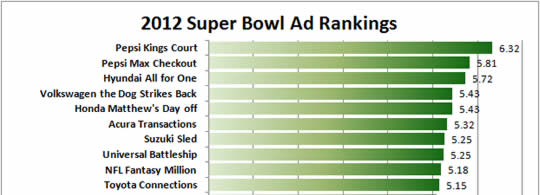Finally: 2012 Super Bowl Ad Neuro-Rankings

Every year, we look forward to how the Super Bowl ads stacked up from a neuromarketing standpoint, courtesy of Sands Research. It’s taken a little longer this year, but the results are in!
Pepsi Dominates
One company, Pepsi, swept the top two spots this year. Their “Kings Court” and “Pepsi Max Checkout” ranked #1 and #2, with the Kings Court spot scoring well above the rest of the pack.
VW Fails to Three-Peat
In 2010, Volkswagen’s “Punch Dub” ad took the top spot, and in 2011, their “The Force/Little Darth Vader” ad not only took the top spot but set the highest neuro-engagement scores that Sands had ever recorded. This year, VW placed a respectable fourth with “The Dog Strikes Back.” I had wondered whether the Star Wars “bar scene” tacked onto the end of this year’s dog commercial, a slightly obscure reference to “The Force” from last year, would confuse viewers; apparently, the ad didn’t suffer because of that.
How Sands Ranks the Ads
Sands uses a combination of EEG measurement of brain activity, eye tracking, and biometrics to measure the engagement and emotional impact of each ad. The rankings produced are based on their proprietary algorithms. (Other neuromarketing measurement and analysis techniques might produce different results.)
Watch the Brain Movies
[Updated with movie link] You can view the entire list of ad rankings here: Sands Super Bowl Ranking for 2012. You can access the “brain movies,” which show brain activity in conjunction with the commercial playing in real time, here: 2012 Top 5 Ads – Brain Movies.
